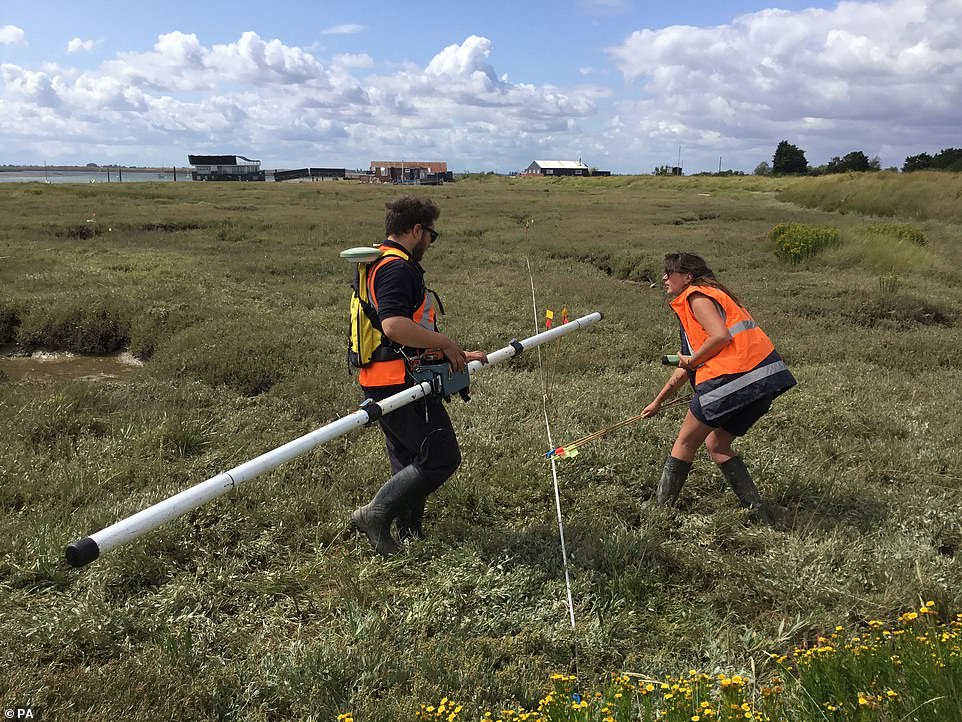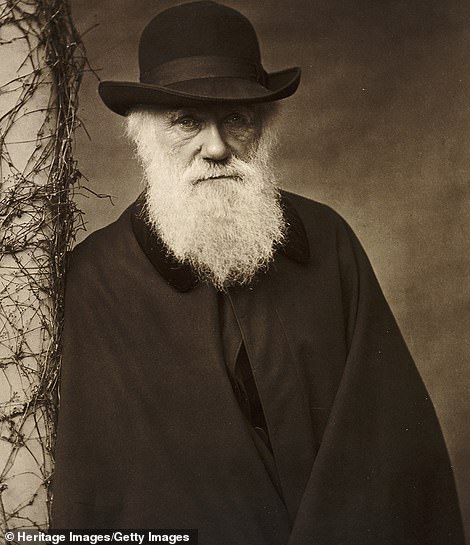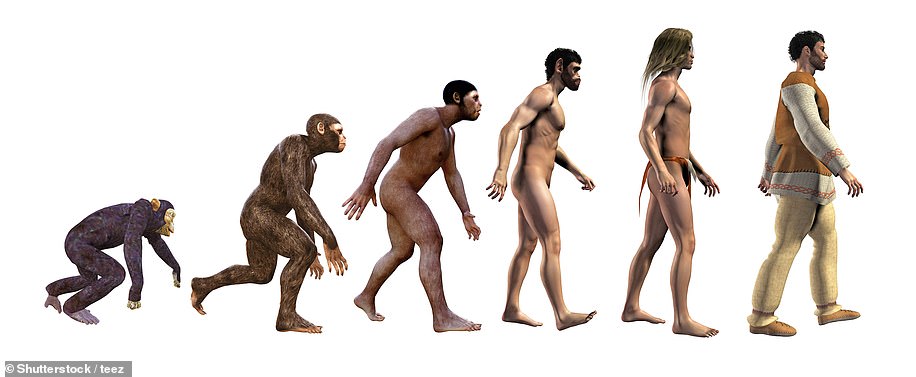Archaeologists have found the dock where the HMS Beagle, the vessel that carried Charles Darwin around the world, was likely dismantled.
A team of experts, commissioned by Historic England, say they have identified the outline of the dock on the mud flats of the River Roach, off Paglesham, Essex, where the ship spent her final days.
The 'father of evolutionary biology' launched a five-year voyage around the world on the Beagle collecting samples and specimens between 1831 and 1836.
Archaeologists uncover the Essex dock 'where Charles Darwin's famous ship HMS Beagle was dismantled' after circumnavigating the globe
A team of experts, commissioned by Historic England, say they have identified the outline of the dock
A specialised drone captured the outline on the mud flats of the River Roach, off Paglesham, Essex
Darwin, known as the 'father of evolutionary biology', launched 5-year voyage around the world on the Beagle
By Jemma Carr For Mailonline
28 October 2019
Archaeologists have found the dock where the HMS Beagle, the vessel that carried Charles Darwin around the world, was likely dismantled.
A team of experts, commissioned by Historic England, say they have identified the outline of the dock on the mud flats of the River Roach, off Paglesham, Essex, where the ship spent her final days.
The 'father of evolutionary biology' launched a five-year voyage around the world on the Beagle collecting samples and specimens between 1831 and 1836.
The ship was navigated by Vice Admiral Robert FitzRoy and journeyed around the tip of South America and onwards to the Galapagos Islands.
It was during this voyage that Darwin formed his theory of evolution after noticing variations and similarities between living animals and what he believed were fossils of their extinct ancestors.
 Archaeologists have found the dock where the HMS Beagle, the vessel that carried Charles Darwin around the world, was probably dismantled. A team of experts, commissioned by Historic England, say they have identified the outline of the dock on the mud flats of the River Roach, off Paglesham, Essex
Archaeologists have found the dock where the HMS Beagle, the vessel that carried Charles Darwin around the world, was probably dismantled. A team of experts, commissioned by Historic England, say they have identified the outline of the dock on the mud flats of the River Roach, off Paglesham, Essex
 Darwin, known as the 'father of evolutionary biology', launched a five-year voyage around the world on the Beagle collecting samples and specimens between 1831 and 1836
Darwin, known as the 'father of evolutionary biology', launched a five-year voyage around the world on the Beagle collecting samples and specimens between 1831 and 1836
After circumnavigating the globe, the Beagle was refitted as a static watch vessel for the Coastguard in 1845, serving to curb smuggling until it was sold in 1870.
It is believed it may have been dismantled by whoever bought it.
The clear outline was produced thanks to the use of a drone fitted with a specialist camera which captures red, green, infrared and near-infrared light.
The drone looked at the health of plant life to build a picture of any buried remains.
It used the principle of differential growth, the idea that buried features affect vegetation growth above ground, much like the way crop marks are formed in dry weather.
 The clear outline of the dock was produced thanks to the use of a drone fitted with a specialist camera which captures red, green, infrared and near-infrared light. Pictured: Archaeologists from Wessex Archaeology working at the site in Essex
The clear outline of the dock was produced thanks to the use of a drone fitted with a specialist camera which captures red, green, infrared and near-infrared light. Pictured: Archaeologists from Wessex Archaeology working at the site in Essex
 The drone looked at the health of plant life to build a picture of any buried remains. It used the principle of differential growth, the idea that buried features affect vegetation growth above ground, much like the way crop marks are formed in dry weather. Pictured: The mud flats of the River Roach
The drone looked at the health of plant life to build a picture of any buried remains. It used the principle of differential growth, the idea that buried features affect vegetation growth above ground, much like the way crop marks are formed in dry weather. Pictured: The mud flats of the River Roach

It was during his voyage on the Beagle that Darwin formed his theory of evolution after noticing variations and similarities between living animals and what he believed were fossils of their extinct ancestors
Dr Dan Atkinson, director of coastal and marine at Wessex Archaeology, said: 'It has been hugely exciting to work on this project, which is starting to shed some light on the famous ship that carried one of science's most renowned individuals.
'No evidence has yet been found of the Beagle itself.
'It was likely dismantled at the dock, and lots of the material would have been taken and repurposed elsewhere.
'But we know from previous surveys that there are the remains of potentially substantial material in the dock - this could be the remains of the dock itself, another vessel possibly associated with the local oyster fishery, or the Beagle - we can't say for sure.
'Further analysis of data from the previous survey results and our recent survey may tell us more.'
Before it was used to carry Darwin around the world, the vessel was part of a fleet sailed to celebrate King George IV's coronation.
It was the first ever ship to sail beneath the old London Bridge.
The father of evolutionary biology: Who was naturalist Charles Darwin?

Charles Robert Darwin was born in 1809 and died in 1882 aged 73
Charles Robert Darwin was born in Shrewsbury, Shropshire, the fifth of six children of wealthy and well-connected parents.
One of his grandfathers was Erasmus Darwin, a doctor whose book ‘Zoonomia’ had set out a radical and highly controversial idea, that one species could 'transmute' into another. Transmutation is what evolution was then known as.
In 1825, Charles Darwin studied at Edinburgh University, one of the best places in Britain to study science.
It attracted free thinkers with radical opinions including, among other things, theories of transmutation.
Darwin trained to be a clergyman in Cambridge in 1827 after abandoning his plans to become a doctor, but continued his passion for biology.
In 1831, Charles' tutor recommended he go on a voyage around the world on HMS Beagle.
Over the next five years Darwin travelled five continents collecting samples and specimens while investigating the local geology.
With long periods of nothing to do but reflect and read, he studied Charles Lyell's Principles of Geology, which had a profound impact.
The trip also began a life of illness after he suffered terrible sea sickness.
In 1835, HMS Beagle made a five-week stop at the Galapágos Islands, 600 miles off the coast of Ecuador.
There, he studied finches, tortoises and mockingbirds although not in enough detail to come to any great conclusions.
But he was beginning to accumulate observations which were fast building up.
On returning home in 1838, Darwin showed his specimens to fellow biologists and began writing up his travels.
It was then that he started to see how 'transmutation' happened.
He found that animals more suited to their environment survived longer and have more young.
Evolution occurred by a process he called 'Natural Selection' although he struggled with the idea because it contradicted his Christian world view.
Having experienced his grandfather being ostracised for his theories, Darwin collected more evidence, while documenting his travels, until 1851.
 Darwin drew fierce criticism from the Church and some of the press. Many people were shaken by the book's key implication that human beings descended from apes, although Darwin only hinted at it
Darwin drew fierce criticism from the Church and some of the press. Many people were shaken by the book's key implication that human beings descended from apes, although Darwin only hinted at it
He decided to publish his theory after he began to suffer long bouts of sickness.
Some historians suggest that he had contracted a tropical illness while others felt that his symptoms were largely psychosomatic, brought on by anxiety.
In 1858, Darwin received a letter from Alfred Russel Wallace, an admirer of Darwin's from reading about his Beagle voyage.
Wallace arrived at the theory of natural selection independently and wanted Darwin's advice on how to publish.
In 1858, Darwin finally went public giving Wallace some credit for the idea.
Darwin's ideas were presented to Britain's leading Natural History body, the Linnean Society.
In 1859, he published his theory on evolution. It would become one of the most important books ever written.
Darwin drew fierce criticism from the Church and some of the press. Many people were shaken by the book's key implication that human beings descended from apes, although Darwin only hinted at it.
In 1862, Darwin wrote a warning about close relatives having children, he was already worried about his own marriage, having married his cousin Emma and lost three of their children and nursed others through illness.
Darwin knew that orchids were less healthy when they self-fertilised and worried that inbreeding within his own family may have caused problems.
He worked until his death in 1882. Realising that his powers were fading, he described his local graveyard as 'the sweetest place on Earth'.
He was buried at Westminster Abbey.
https://www.dailymail.co.uk/news/ar...arwins-famous-ship-HMS-Beagle-dismantled.html
A team of experts, commissioned by Historic England, say they have identified the outline of the dock on the mud flats of the River Roach, off Paglesham, Essex, where the ship spent her final days.
The 'father of evolutionary biology' launched a five-year voyage around the world on the Beagle collecting samples and specimens between 1831 and 1836.
Archaeologists uncover the Essex dock 'where Charles Darwin's famous ship HMS Beagle was dismantled' after circumnavigating the globe
A team of experts, commissioned by Historic England, say they have identified the outline of the dock
A specialised drone captured the outline on the mud flats of the River Roach, off Paglesham, Essex
Darwin, known as the 'father of evolutionary biology', launched 5-year voyage around the world on the Beagle
By Jemma Carr For Mailonline
28 October 2019
Archaeologists have found the dock where the HMS Beagle, the vessel that carried Charles Darwin around the world, was likely dismantled.
A team of experts, commissioned by Historic England, say they have identified the outline of the dock on the mud flats of the River Roach, off Paglesham, Essex, where the ship spent her final days.
The 'father of evolutionary biology' launched a five-year voyage around the world on the Beagle collecting samples and specimens between 1831 and 1836.
The ship was navigated by Vice Admiral Robert FitzRoy and journeyed around the tip of South America and onwards to the Galapagos Islands.
It was during this voyage that Darwin formed his theory of evolution after noticing variations and similarities between living animals and what he believed were fossils of their extinct ancestors.


After circumnavigating the globe, the Beagle was refitted as a static watch vessel for the Coastguard in 1845, serving to curb smuggling until it was sold in 1870.
It is believed it may have been dismantled by whoever bought it.
The clear outline was produced thanks to the use of a drone fitted with a specialist camera which captures red, green, infrared and near-infrared light.
The drone looked at the health of plant life to build a picture of any buried remains.
It used the principle of differential growth, the idea that buried features affect vegetation growth above ground, much like the way crop marks are formed in dry weather.



It was during his voyage on the Beagle that Darwin formed his theory of evolution after noticing variations and similarities between living animals and what he believed were fossils of their extinct ancestors
Dr Dan Atkinson, director of coastal and marine at Wessex Archaeology, said: 'It has been hugely exciting to work on this project, which is starting to shed some light on the famous ship that carried one of science's most renowned individuals.
'No evidence has yet been found of the Beagle itself.
'It was likely dismantled at the dock, and lots of the material would have been taken and repurposed elsewhere.
'But we know from previous surveys that there are the remains of potentially substantial material in the dock - this could be the remains of the dock itself, another vessel possibly associated with the local oyster fishery, or the Beagle - we can't say for sure.
'Further analysis of data from the previous survey results and our recent survey may tell us more.'
Before it was used to carry Darwin around the world, the vessel was part of a fleet sailed to celebrate King George IV's coronation.
It was the first ever ship to sail beneath the old London Bridge.
The father of evolutionary biology: Who was naturalist Charles Darwin?

Charles Robert Darwin was born in 1809 and died in 1882 aged 73
Charles Robert Darwin was born in Shrewsbury, Shropshire, the fifth of six children of wealthy and well-connected parents.
One of his grandfathers was Erasmus Darwin, a doctor whose book ‘Zoonomia’ had set out a radical and highly controversial idea, that one species could 'transmute' into another. Transmutation is what evolution was then known as.
In 1825, Charles Darwin studied at Edinburgh University, one of the best places in Britain to study science.
It attracted free thinkers with radical opinions including, among other things, theories of transmutation.
Darwin trained to be a clergyman in Cambridge in 1827 after abandoning his plans to become a doctor, but continued his passion for biology.
In 1831, Charles' tutor recommended he go on a voyage around the world on HMS Beagle.
Over the next five years Darwin travelled five continents collecting samples and specimens while investigating the local geology.
With long periods of nothing to do but reflect and read, he studied Charles Lyell's Principles of Geology, which had a profound impact.
The trip also began a life of illness after he suffered terrible sea sickness.
In 1835, HMS Beagle made a five-week stop at the Galapágos Islands, 600 miles off the coast of Ecuador.
There, he studied finches, tortoises and mockingbirds although not in enough detail to come to any great conclusions.
But he was beginning to accumulate observations which were fast building up.
On returning home in 1838, Darwin showed his specimens to fellow biologists and began writing up his travels.
It was then that he started to see how 'transmutation' happened.
He found that animals more suited to their environment survived longer and have more young.
Evolution occurred by a process he called 'Natural Selection' although he struggled with the idea because it contradicted his Christian world view.
Having experienced his grandfather being ostracised for his theories, Darwin collected more evidence, while documenting his travels, until 1851.

He decided to publish his theory after he began to suffer long bouts of sickness.
Some historians suggest that he had contracted a tropical illness while others felt that his symptoms were largely psychosomatic, brought on by anxiety.
In 1858, Darwin received a letter from Alfred Russel Wallace, an admirer of Darwin's from reading about his Beagle voyage.
Wallace arrived at the theory of natural selection independently and wanted Darwin's advice on how to publish.
In 1858, Darwin finally went public giving Wallace some credit for the idea.
Darwin's ideas were presented to Britain's leading Natural History body, the Linnean Society.
In 1859, he published his theory on evolution. It would become one of the most important books ever written.
Darwin drew fierce criticism from the Church and some of the press. Many people were shaken by the book's key implication that human beings descended from apes, although Darwin only hinted at it.
In 1862, Darwin wrote a warning about close relatives having children, he was already worried about his own marriage, having married his cousin Emma and lost three of their children and nursed others through illness.
Darwin knew that orchids were less healthy when they self-fertilised and worried that inbreeding within his own family may have caused problems.
He worked until his death in 1882. Realising that his powers were fading, he described his local graveyard as 'the sweetest place on Earth'.
He was buried at Westminster Abbey.
https://www.dailymail.co.uk/news/ar...arwins-famous-ship-HMS-Beagle-dismantled.html

